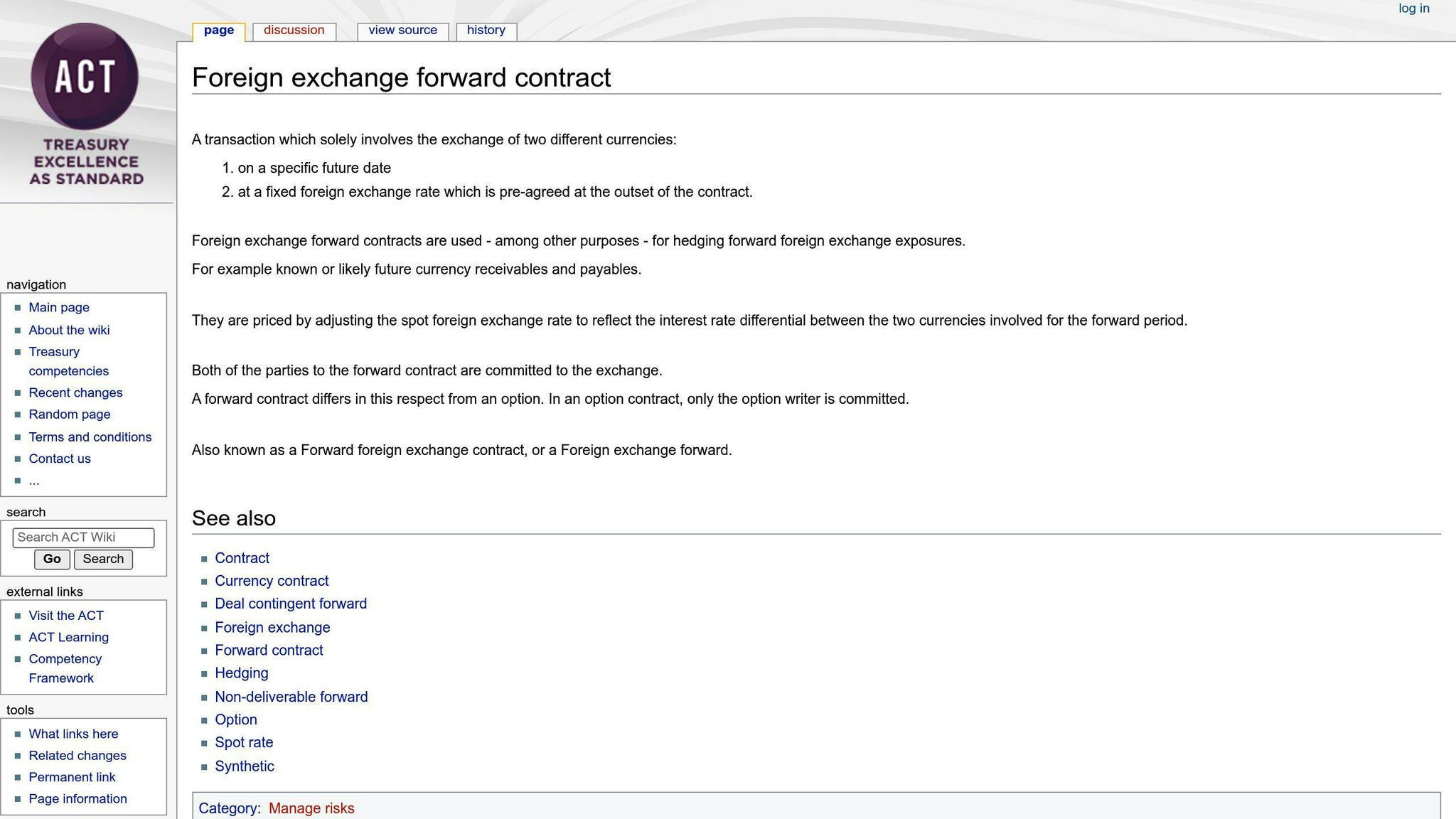FX forward contracts are agreements between two parties to exchange currencies at a fixed rate on a future date. They help businesses manage currency risks, ensuring predictable costs and revenue despite market fluctuations. Here's what you need to know:
-
Key Features:
- Fixed exchange rate.
- Customisable terms (amount, settlement date).
- No upfront premium required.
-
Benefits:
- Protects against unfavourable currency shifts.
- Enables accurate financial planning.
- Useful for international trade, cross-border investments, and managing foreign income.
-
Risks:
- Locked rates can limit gains if the market moves favourably.
- Cost of hedging may be significant for long contract maturity dates.
- If the market moves favourably, you may need to post further collateral (margin calls)
FX forward contracts are ideal for businesses or individuals dealing with foreign currencies who prioritise stability over potential market gains. They are most effective when used with a clear understanding of your financial needs and market conditions.
Mechanics of FX Forward Contracts

Components of FX Forward Contracts
FX forward contracts outline the currency amount, fixed exchange rate, and maturity date, offering clear terms for future transactions. The forward rate is calculated using the spot rate and adjusted for the interest rate difference between the two currencies over the contract's duration. This ensures that forward contracts align with market dynamics, making them a useful tool for managing currency risk.
Steps to Establish an FX Forward Contract
To set up an FX forward contract, clients first evaluate their currency risk and decide on the required amount and timeline. They then negotiate terms with financial providers, who determine the forward rate based on factors including the spot rate, interest rate differences, contract length, market conditions, and credit and risk appetite. Once agreed upon, the contract is finalised, often requiring a deposit or margin to be settled.
Settlement Options for FX Forward Contracts
At maturity, there are two ways to settle an FX forward contract:
- Physical Delivery: The agreed currencies are exchanged on the maturity date. For example, if a U.S. company agrees to purchase €2 million at $1 = €0.90, they would pay $2.22 million to receive the euros upon maturity.
- Cash Settlement: Instead of exchanging currencies, the difference between the contract rate and the spot rate at maturity is settled in cash. This option is ideal when no physical currency exchange is needed. This contract type is called “cash-settled” and is how Non-Deliverable Forwards (NDFs) for currencies that aren’t directly deliverable work.
The choice of settlement depends on the specific requirements of the business. Companies involved in international trade often prefer physical delivery for meeting payment obligations, while investors or speculators may favour cash settlement.
Longer contract durations come with higher risks, as they allow more time for market conditions to shift significantly. Having a clear grasp of how FX forward contracts work is essential for leveraging their benefits and strategic uses.
Advantages and Applications of FX Forward Contracts
Benefits of FX Forward Contracts
FX forward contracts are a practical solution for businesses and individuals involved in international transactions. One of their biggest perks is the ability to lock in exchange rates for future deals. This helps maintain stable profit margins and allows for more accurate financial planning. By fixing today's exchange rate, companies can predict costs and revenues, making budgeting easier, especially for businesses with frequent international payments or tight profit margins.
These features make FX forward contracts a reliable option for managing currency risks across various financial situations.
Common Uses for FX Forward Contracts
FX forward contracts shine in several business and personal scenarios:
- International Trade Payments: Importers and exporters can use these contracts to shield themselves from currency swings that might occur between placing an order and making the payment. This is particularly useful for businesses with long lead times.
- Cross-Border Investments: Companies planning large overseas investments can secure exchange rates for future capital transfers. This removes uncertainty around the final cost of acquisitions or investments abroad.
- Expatriate Income Management: Workers earning income in foreign currencies can use forward contracts to lock in rates for converting their salaries. This ensures financial predictability and simplifies personal budgeting.
Example: How FX Forward Contracts Work in Business
Here’s a practical example:
A manufacturing company plans to import machinery from Europe, valued at €2 million, with payment due in six months. To avoid the risk of currency fluctuations, the company enters into an FX forward contract at a rate of $1 = €0.90. This ensures:
- Stable Costs: The USD payment amount is fixed.
- Profit Margin Protection: Costs are predictable, safeguarding margins.
- Better Planning: Financial forecasting and budgeting become more accurate.
While FX forward contracts are a powerful tool for managing currency risks, their success depends on understanding specific business needs and market conditions. Companies should also weigh the impact of locking in rates for extended periods against their cash flow requirements.
Risks and Limitations of FX Forward Contracts
Risk of Fixed Exchange Rates
While FX forward contracts offer stability, they can also limit potential gains. Locking in an exchange rate means missing out if the market shifts in your favour. For instance, if your business secures a rate of $1 = €0.90 and the market later rises to $1 = €0.95, you're obligated to trade at the less favourable rate.
This lack of flexibility can be a challenge, especially in markets prone to sudden currency fluctuations.
Impact on Cash Flow and Margin
These contracts can also strain cash flow due to margin requirements and market shifts. If the market moves significantly, you might face margin calls or increased payment obligations, which can disrupt financial planning. Read our blog on margin calls here: https://www.okumarkets.com/blog/mtm-margin-calls/
For example, committing to purchase €2 million through a forward contract could result in higher costs compared to the spot rate at the time of settlement.
Risks Associated with Contract Duration
The longer the contract, the greater the exposure to risks like market volatility, economic changes, and forecasting inaccuracies. A 12-month forward contract, for example, carries far more uncertainty than a 1-month agreement, especially when dealing with unstable currencies or large sums.
These risks need to be carefully considered alongside the stability and predictability that FX forward contracts offer. Weighing these factors is essential to determine if they fit within your financial strategy.
sbb-itb-6b3a4a4
Comparison of FX Forward Contract Pros and Cons
When evaluating FX forward contracts, it's important to balance their advantages against their drawbacks. Here's a breakdown to help you understand both sides.
Pros and Cons Table
| Benefit | Description | Drawback | Description |
|---|---|---|---|
| Exchange Rate Certainty | Allows for precise budgeting | Fixed Rate Obligation | Requires commitment to less favourable rates |
| Risk Mitigation | Protects against unfavourable currency changes | No Participation | Unable to participate in favourable exchange rate movements |
| Customisable Terms | Tailored amounts and settlement dates | Limited Flexibility | Terms cannot be adjusted once agreed upon |
| No Upfront Premium | No initial premium payments are needed | Cash Flow Impact | Might strain cash flow due to deposits or margin calls |
Whether FX forward contracts are the right fit depends on your business goals, risk tolerance, and market conditions. Companies focused on stable cash flows often find these contracts useful, while those needing more flexibility might explore other options.
Conclusion and Key Points
Key Points Summary
FX forward contracts are valuable for managing currency risks in international transactions. They help businesses maintain financial stability even in unpredictable foreign exchange markets .
The pricing of forward rates is based on the spot price, interest rate differences, and contract length.
By understanding and applying these principles, businesses can use FX forward contracts to handle currency risks effectively.
Recommendations for Using FX Forward Contracts
Here are some practical steps to get the most out of FX forward contracts:
Assessment and Planning
- Evaluate your exposure to currency risks, including future payment amounts and schedules.
- Align your approach with your company’s risk tolerance and cash flow needs.
Implementation Strategy
- Start with short-term contracts and keep reserves ready for potential margin calls.
- Partner with experienced providers who offer clear pricing and expert advice.
"The key to successful currency risk management lies in understanding your exposure and implementing appropriate hedging strategies. FX forward contracts offer a straightforward solution for businesses seeking predictability in their international transactions."
Collaborating with reputable providers ensures tailored strategies that reduce risks and maximise benefits.
The success of FX forward contracts depends on your business goals and the market environment. Since long-term contracts can be more volatile, starting with shorter durations is often a safer choice. By analysing these factors and working with knowledgeable providers, you can create a strong currency risk management plan that supports both business growth and financial stability.
FAQs
How to calculate the price of FX forward?
The forward rate is determined by combining the spot rate with the interest rate differences between the two currencies:
Forward Rate = Spot Rate × (1 + Quote Currency Interest Rate) / (1 + Base Currency Interest Rate)
For example, if the spot rate is 1.30, with an interest rate of 0.5% for the Base currency and 0.25% for the Quote currency, the forward rate would be 1.2967.
Read more here: https://www.okumarkets.com/blog/forward-pricing/
This formula helps businesses secure rates that align with market conditions and interest rate variations, making forward contracts a useful tool for managing currency risks.
When to use a forward contract?
Forward contracts are helpful for managing fixed payments, navigating uncertain markets, or staying on top of budgeting needs.
Best Scenarios:
- Managing fixed future payments or receipts in a foreign currency
- Dealing with periods of high currency volatility
- Ensuring accurate budget planning
Example in Action: A U.S. company might lock in a rate of $1 = €0.90 for a €2M payment due in a year. This strategy safeguards against potential currency swings.
While forward contracts offer stability, businesses should also consider the risks of locking in rates and how it might affect cash flow. These contracts typically span from one day to five years, though shorter terms often provide more flexibility and lower risk.
To decide if a forward contract is right for you, evaluate your business's specific needs and tolerance for currency risk, especially regarding exposure to exchange rate movements.

